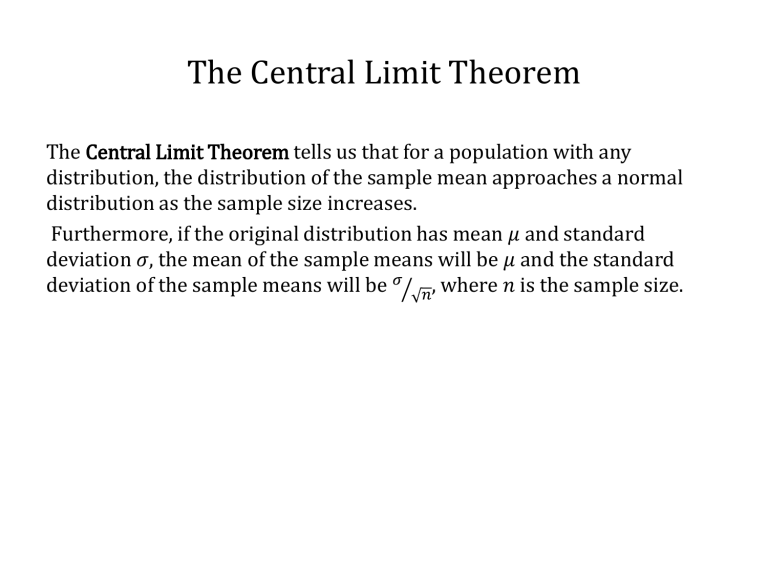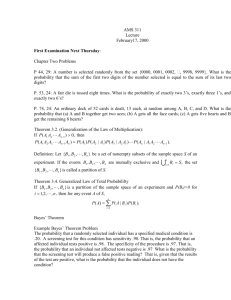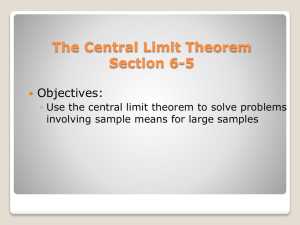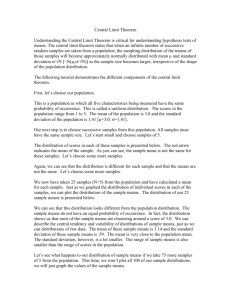The Central Limit Theorem

The Central Limit Theorem
The Central Limit Theorem tells us that for a population with any distribution, the distribution of the sample mean approaches a normal distribution as the sample size increases.
Furthermore, if the original distribution has mean 𝜇 and standard deviation 𝜎, the mean of the sample means will be 𝜇 and the standard 𝑛
, where 𝑛 is the sample size.
The Central Limit Theorem
Principles to use the Central Limit Theorem
1.
For a population with any distribution, if 𝑛 > 30, then the sample means will have a distribution that can be approximated by a normal 𝑛
.
2.
If 𝑛 ≤ 30 and the original population has a normal distribution, then the sample means have a normal distribution with mean 𝜇 and 𝑛
.
3.
If 𝑛 ≤ 30 and the original population does not have a normal distribution, then we cannot apply the central limit theorem!
The Central Limit Theorem
If all possible random samples of size n are selected from a population with mean 𝜇 and standard deviation 𝜎, the mean of the sample means is denoted by 𝝁 𝒙
, so 𝝁 𝒙
= 𝝁
Also the standard deviation of the sample means is denoted by 𝝈 𝒙
, so 𝝈 𝝈 𝒙
= 𝒏 𝜎 𝑥 is called the standard error of the mean.
The Central Limit Theorem
Note:
Individual value:
When working with individual values from a normally 𝒙−𝝁 distributed population, use the methods from last class. Use 𝒛 = 𝝈
Sample of values
: When working with a mean for some
sample
(or group), be sure to use the value of 𝜎/ 𝑛 for the standard deviation of the sample means. Use 𝒛 = 𝒙−𝝁 𝝈
.
𝒏
The Central Limit Theorem
A water taxi sank in Baltimore’s Inner Harbor. Assume the weights of men is are normally distributed with a mean of 172 lb. and a standard deviation of 29 lb. a.
Find the probability that if an
individual
man is randomly selected, his weight will be greater than 175 lb.
The Central Limit Theorem
A water taxi sank in Baltimore’s Inner Harbor. Assume the weights of men is are normally distributed with a mean of 172 lb. and a standard deviation of 29 lb. a.
Find the probability that if an
individual
man is randomly selected, his weight will be greater than 175 lb.
b.
Find the probability that 20
randomly selected
men will have a mean weight that is greater than 175 lb.
The Central Limit Theorem
Recall the Rare Event rule for inferential Statistics
If under a given assumption, the probability of a particular observed event is exceptionally small (such as less than 0.05), we conclude that the assumption is probably not correct.
The Central Limit Theorem
The lengths of pregnancies are normally distributed with a mean of 268 days and a standard deviation of 15 days. a) If 1 pregnant woman is randomly selected, find the probability that her length of pregnancy is less than 260 days.
The Central Limit Theorem
The lengths of pregnancies are normally distributed with a mean of 268 days and a standard deviation of 15 days. a) If 1 pregnant woman is randomly selected, find the probability that her length of pregnancy is less than 260 days.
b) If 25 randomly selected women are put on a special diet just before they become pregnant, find the probability that their lengths of pregnancy have a mean that is less than 260 days.
The Central Limit Theorem
The lengths of pregnancies are normally distributed with a mean of 268 days and a standard deviation of 15 days. a) If 1 pregnant woman is randomly selected, find the probability that her length of pregnancy is less than 260 days.
b) If 25 randomly selected women are put on a special diet just before they become pregnant, find the probability that their lengths of pregnancy have a mean that is less than 260 days.
c) If the 25 women do have a mean of less that 260 days, does it appear that the, does it appear that the diet has an effect on the length of pregnancy?
The Central Limit Theorem
Membership in Mensa requires and IQ score of above 131.5. Nine candidates take IQ tests, and their summary results indicated that their mean IQ score is 133. (IQ scores are normally distributed with a mean of
100 and a standard deviation of 15).
a) If 1 person is randomly selected from the general population, find the probability of getting someone with an IQ score of at least 133.
The Central Limit Theorem
Membership in Mensa requires and IQ score of above 131.5. Nine candidates take IQ tests, and their summary results indicated that their mean IQ score is 133. (IQ scores are normally distributed with a mean of
100 and a standard deviation of 15).
a) If 1 person is randomly selected from the general population, find the probability of getting someone with an IQ score of at least 133.
b) If 9 people are randomly selected, find the probability that their mean
IQ is at least 133.
The Central Limit Theorem
Membership in Mensa requires and IQ score of above 131.5. Nine candidates take IQ tests, and their summary results indicated that their mean IQ score is 133. (IQ scores are normally distributed with a mean of
100 and a standard deviation of 15).
a) If 1 person is randomly selected from the general population, find the probability of getting someone with an IQ score of at least 133.
b) If 9 people are randomly selected, find the probability that their mean
IQ is at least 133.
c) Although the summary results are available, the individual scores have been lost. Can is be concluded that all 9 candidates have IQ scores above 131.5 so that they are all eligible for Mensa membership?
Group Quiz
Tall Clubs International is a social organization for tall people. It has a requirement that men must be at least 74 in. tall, and women must be at least 70 in. tall.
• Heights of men are normally distributed with mean 69 in. and standard deviation 2.8 in.
• Heights of women are normally distributed with mean 63.6 in and standard deviation 2.5 in.
a.
What percentage of men meet that requirement?
b.
What percentage of women meet that requirement?
c.
Are the height requirements for men and women fair? Why or Why not?
d.
If the height requirements are changed for both men and women what would the new minimum heights be for both men and women?
•
6-3: 1-25 odd
Homework!!







